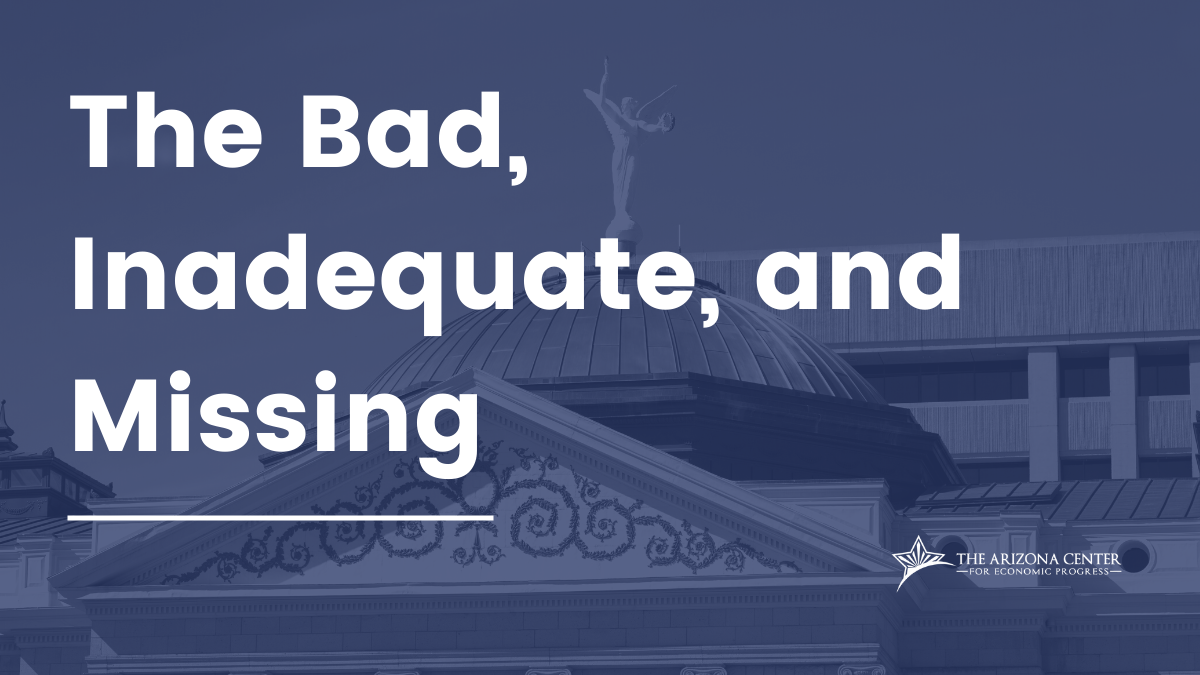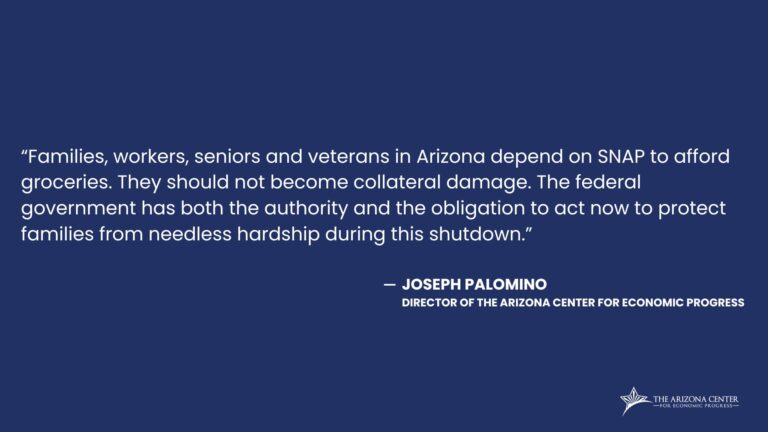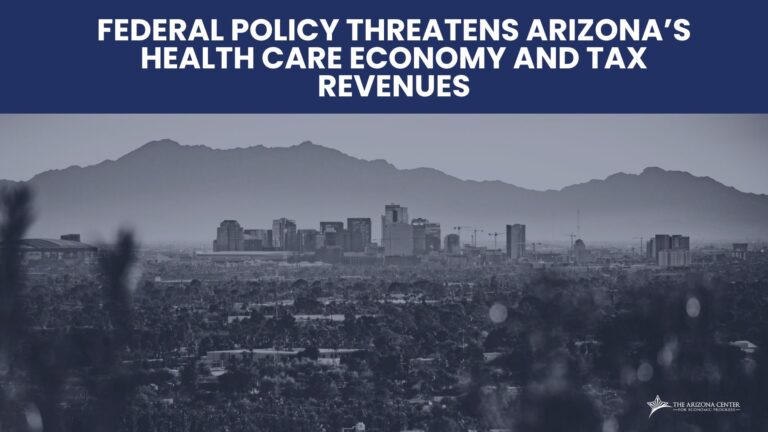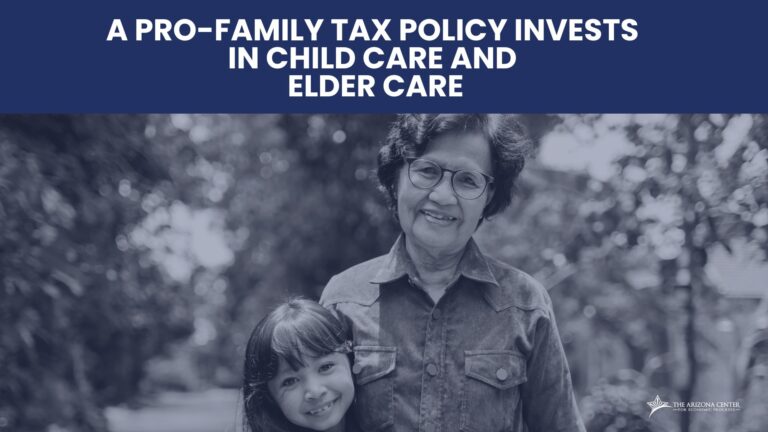
The Bad, Inadequate, & Missing – AZCenter’s take on the latest state budget proposal
With only eight days left before the deadline (and a state government shutdown), the Arizona Legislature has begun serious negotiations on a state budget proposal revealed this past Monday. As the AZCenter has previously pointed out, state revenues have skyrocketed, resulting in a massive surplus of over $5 billion in one-time and ongoing resources.
And yet despite this once-in-a-generation opportunity, the proposed budget still misses the mark by misallocating resources (the “Bad”), not investing enough in what matters (the “Inadequate”), or missing key priorities altogether (the “Missing”).
WHAT’S BAD, INADEQUATE, AND MISSING IN THE BUDGET PROPOSAL
Arizonans are ready to give schools the resources they need, address the state’s worsening affordable housing crisis, enact paid family and medical leave for all, and expand economic opportunity through increased child care and tuition assistance—to name a few. It’s time to make sure our elected leaders hear this as they finalize the budget.
THE BAD:
Allocating resources to border enforcement instead of supporting immigrant households
The proposed budget includes large investments in border security (over $500 million in one-time funding, and $20 million in ongoing funding). Yet at the same time, the budget has no new support for mixed-status households to afford basic needs, attend school or university, or participate in the economy. Approximately 1 in 4 Arizona children are growing up in a mixed-status household, and many of the federal economic supports available during the COVID-19 recession were unavailable to these families. An equitable recovery requires providing these households with the resources they need to thrive, like subsidies for child care or adult education—the very things that would help them take part in the economy.
Allocating resources to corrections and public safety and not to re-entry and rehabilitation
The proposed budget includes significant increases to the Department of Corrections and Department of Public Safety, including the largest salary increase (as a percent) among all state employees, increases to private prison contracts, and a new fleet for DPS (totaling over $150 million in ongoing funding and $20 million in one-time funding for those purposes alone). Meanwhile, the budget has merely $6.8 million in ongoing funds for rehabilitation and re-entry services, and no added support for justice-involved individuals to help them meet their basic needs and take part in the economy.
Funding gimmicks and tax cuts for K-12 public education
The proposed budget eliminates the State Equalization Tax Rate (SETR), a property tax that funds part of K-12 public education in Arizona. The budget proposal plans to replace property tax dollars with the state’s General Fund—a more regressive and unstable source of funding. Switching from SETR to General Fund also puts the state closer to the triggers that will limit K-12 funding (known as the Prop 123 triggers). The biggest beneficiaries from this change are large commercial property entities.
More tax credits for the wealthiest households
The proposed budget increases the annual cap for individual and corporate tax credits for contributions to Student Tuition Organizations (STOs), tax-exempt nonprofit organizations that provide private school vouchers. This would reduce state revenues by over $10 million annually starting in Fiscal Year 2024. Every year, STOs and private school vouchers divert funding from public schools to private schools. And the tax credit, claimed by corporations and the wealthy in Arizona, makes the state’s tax code even more regressive.
More private school vouchers (despite rejection by voters in 2018)
While not in the budget itself, a budget deal is contingent on a major expansion of private school vouchers, known in Arizona as Empowerment Scholarship Accounts (ESAs). Even though Arizona voters overwhelmingly rejected private school vouchers at the ballot box, lawmakers continue to want to divert more public tax dollars away from underfunded public schools to private schools.
THE INADEQUATE:
Restoring funding for community colleges
The proposed budget includes additional funding for Science, Technology, Engineering, and Mathematics (STEM) programs at Maricopa, Pima, and Pinal County community college districts (about $11 million in ongoing funding). Yet, the state has provided no operating state aid to Maricopa and Pima community colleges since 2015, Arizona’s two largest community colleges. To connect more students with the training that they need to succeed in their careers, the state should restore this support for community colleges.
Funding for public K-12 education (as directed by voters in 2020)
While the proposed budget includes some added resources for K-12 public education, Arizona still remains among the bottom across the nation in terms of per-pupil spending. These increases will have little impact on improving pay disparities among school professionals and addressing the long-standing teacher shortage. The proposal includes $1.2 billion in General Fund support for K-12 education, but more than half of that is fund shifts and one-time resources ($339 million is a fund shift resulting from elimination of the state equalization tax and replacing it with General Fund dollars and another $339 million is one-time funding for Fiscal Year 2023). This proposal also includes the creation of an opportunity weight to direct more state resources to districts with higher shares of students experiencing poverty. Yet unfortunately, the opportunity weight doesn’t go far enough. In a state where approximately 1 in 4 children is experiencing poverty, $100 million is inadequate to address the immediate needs of Arizona’s students. Additionally, the opportunity weight doesn’t go into full effect until Fiscal Year 2024.
Financial aid for postsecondary education
While the proposed budget includes more funding for promise scholarships and free in-state tuition for spouses of GI bill recipients ($22 million combined ongoing), far too many non-traditional students in Arizona face barriers to attending and affording higher education. Today, the Financial Aid Trust fund receives $10 million less per year than the statutory requirement.
Affordable housing
The proposed budget includes a $60 million one-time General Fund deposit into Arizona’s Housing Trust Fund (with $20 million set aside for rural areas and $4 million set aside for tribal communities), a flexible fund administered by state government to make housing more affordable, through direct assistance to households and to finance the construction of affordable housing developments. With housing costs rapidly rising in Arizona, renters are shouldering higher and higher cost-burden. With no end in sight for increasing home values and rent, the legislature should restore the Housing Trust Fund to a dedicated, ongoing, and adequate funding source to meet the growing challenge in the years to come.
School facilities investments
The proposed budget increases funding for school facilities (building renewal) by $200 million in one-time funds. However, this is a mere fraction of the funds required for Arizona to make headway in the large backlog of school facilities projects. Since the legislature repealed the school building renewal formula in 2013, schools have been short-changed by over $3 billion. These are crucial updates and repairs that are needed to create safe, healthy, and effective learning environments for all Arizona students.
Health coverage eligibility expansion
While the proposed budget includes some health care funding for families and children (including the Healthy Families program, postpartum Medicaid coverage, and Medicaid eligibility for foster youth), the legislature could do more to connect Arizonans with the affordable care that they need. Arizona has the fourth highest rate of uninsured children in the U.S., and more than 16,000 children–10 percent of all uninsured children in Arizona—live in households earning slightly too much to qualify for KidsCare. A $12 million appropriation could expand KidsCare eligibility to thousands of Arizona children.
THE MISSING:
Raising the school spending limit
The proposed budget package does not include any mechanism to increase or repeal the state’s K-12 spending limit (known as the Aggregate Expenditure Limit, or AEL). Any new investments in public education will be meaningless if schools cannot spend those dollars. That will almost certainly be the case next year and every year thereafter unless the legislature refers a measure to the November ballot to either repeal or modernize the outdated school spending limit in the state constitution. Currently, the school spending limit is outdated based on what it cost to educate students in 1980.
State investments in child care
Missing are any new investments to make child care more affordable. Child care, which allows parents to work and for children to learn, is crucial to Arizona’s economy. Yet for the past decade, Arizona has eliminated almost all state funding for resources to make child care more affordable for Arizona families. And while federal funds have provided important resources, these are set to expire soon, which will leave families with fewer child care options.
Expanding cash assistance to more families
Missing from the budget are any resources to directly help the lowest-income families in the state (and those bearing the brunt of cost-of-living increases). Over the past few decades, fewer and fewer Arizona families with children in poverty have been able to access the state’s cash assistance program. While benefit cuts and strict eligibility requirements have eroded the effectiveness of Arizona’s cash assistance program, the state has used the majority of its federal TANF funds to prop up its Department of Child Safety (DCS), instead of funding that agency through the state’s General Fund. This year, Arizona can make sure the lowest-income families can meet their basic needs by restoring the cash assistance program.
Enacting a statewide Paid Family and Medical Leave program
Missing from the budget negotiations is a statewide Paid Family and Medical Leave social insurance program which would provide all qualifying workers in Arizona with adequate time away from work to care for themselves, a newborn, or a loved one—without jeopardizing their job. A recent survey found that only 1 in 4 Arizona workers have access to paid family leave.



